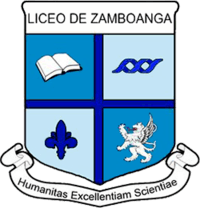Liceo de Zamboanga
| Liceo de Zamboanga Humanitas Excellentiam Scientiae | |
|---|---|
 Official school logo | |
| Location | |
|
San Carlos, Tukuran Philippines, Zamboanga del Sur 7019 | |
| Information | |
| School type | Non-profit and non-sectarian |
| Established | October 21, 2004 |
| Opened | April 3, 2004 |
| Status | Under press release |
| Specialist | Pre-school |
| School number | 1 |
| School code | LDZ |
| Staff | 3 |
| Grades | Complete preschool (nursery, Kindergarten and preparatory) and grade school |
| Age range | 3-8 |
| Enrollment | 60 |
| Language | English |
| Color(s) | Light blue and light red |
| Nickname | Lician or LDZians |
| Affiliations | United States of America Embassy, Royal Norwegian Embassy in Manila, United Kingdom Embassy, Tanzania Embassy, and Taipei Economic and Cultural Office in the Philippines |
| Website |
www |
Liceo de Zamboanga is a school in San Carlos, Tukuran, Zamboanga del Sur with an international-oriented curriculum founded in 2004. The curriculum experts and advisers are diverse, as they are people of many heritages, many of whom came from Northern Illinois University and University of California at Berkeley, U.S.A.
Curriculum
The school curriculum of LDZ is based upon the framework of The Creative Curriculum (The Creative Curriculum for Preschool, Fourth Edition, by Diane Trister Dodge, Laura J. Colker, and Cate Heroman) and the Montessori method. The program uses a variety of activities to achieve several broad goals, including getting along well with others, becoming enthusiastic learners, and getting prepared for the expectations of the Department of Education that "all Grade 1 entrants [should] develop the necessary learning experiences to prepare them for academic work." The school does this by creating purposeful and productive play experiences.
Campus
The building construction incorporated many environmentally sensitive design features, like high ceilings, to maintain comfortable room temperature. The rooms are designed not to use air conditioning to minimize unnecessary energy consumption, making the school building environmentally sound. The building is made of modern construction materials like concrete cement for the walls and metal sheets for roofing. Another important material incorporated in the building is the local coconut lumber, a statement of the school administrator’s support of the use of indigenous material for construction.
Administration members
- Marithel Ignacio Respicio, Southern Mindanao Colleges, Pagadian City, Philippines
- Jacinta Suan-Respicio, Trisha Faye Concrete Products, Tukuran, Zamboanga del Sur, Philippines
- Mayla Cadungog-Marcos, MSU-Iligan Institute of Technology, Iligan City, Philippines
- Rachel Canete Respicio, University of Cebu, Cebu City, Philippines